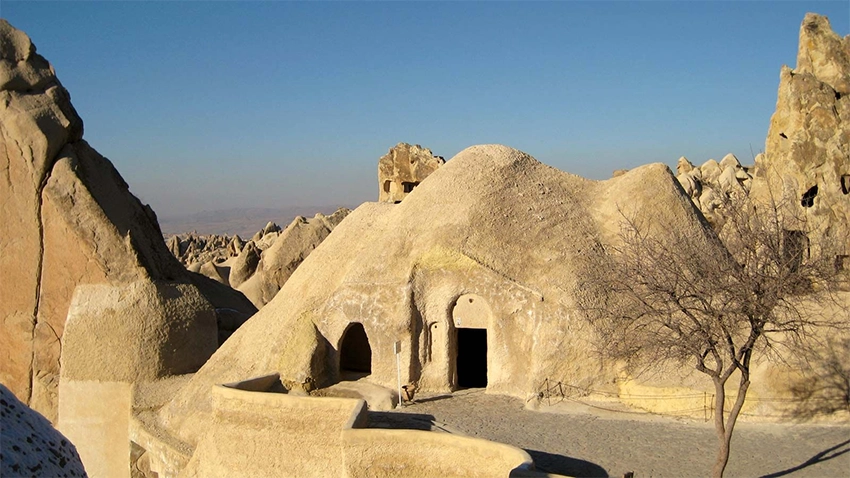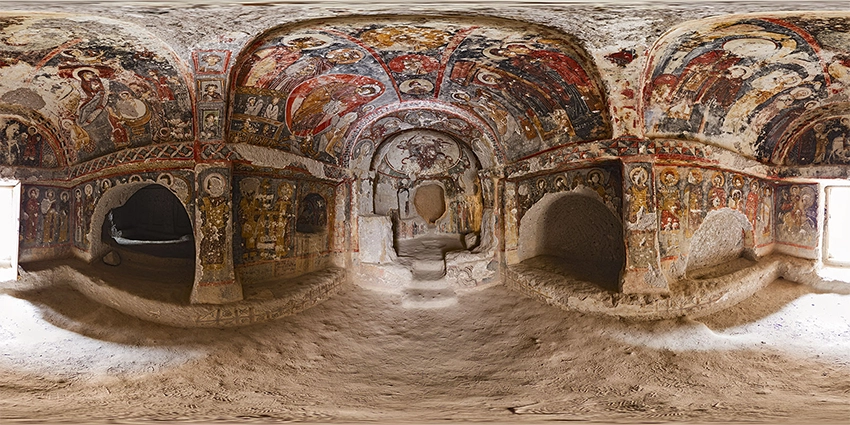Barbara Church
Barbara Church – A Martyr’s Memorial in the Göreme Open-Air Museum
Historical Background
Located in the heart of Cappadocia within the Göreme Open-Air Museum, the Church of Saint Barbara is dedicated to the memory of a Christian martyr. According to tradition, Barbara lived during the Roman era and was executed by her own father for choosing Christianity. Her father himself was struck down by divine punishment shortly afterward. This dramatic story not only gave the church its name but also inspired much of its interior decoration.

The church was carved in the late 11th century during the Byzantine period. Its architectural style is similar to that of Çarıklı Church, reflecting the shared techniques of Cappadocian stone masters.
Architecture
Barbara Church follows a cruciform plan. A central dome is balanced by three apses to the east, with smaller apses to the north and south. Two columns support the cross-vaulted system beneath the dome. As with most Cappadocian churches, the structure was carved directly into soft volcanic tuff, leaving the exterior plain and unadorned.
Inside, two rectangular entrances, simple arches, and modest wall treatments emphasize functional design. The church remains structurally sound, though some frescoes have deteriorated and certain sections are now roped off to protect them.
Frescoes and Iconography
The paintings inside Barbara Church are among the more austere examples of Byzantine iconography:
- The dome features Christ Pantocrator, enthroned and surrounded by geometric motifs, painted directly onto the stone with red pigments.
- On the north wall, Saint George and Saint Theodore appear on horseback, battling a dragon.
- Angel figures, symbolic crosses, and mosaic-style decorations line the remaining surfaces. Some crosses were incised directly into the walls rather than painted.

The palette includes red, blue, white, and black, all derived from natural mineral pigments. The scenes carry not just decorative but also didactic value, emphasizing faith, martyrdom, and divine justice.
Religious and Cultural Context
Saint Barbara is venerated as the protector against fire, lightning, and sudden death. For centuries, local communities came here to pray for rain, fertility, and protection. The church also functioned as a ritual site for Cappadocian farmers, linking faith with the rhythms of rural life.
Built before the Second Crusade, it is considered one of the region’s rare martyr chapels, symbolizing both devotion and resilience.
Visiting Barbara Church
- Location: Inside Göreme Open-Air Museum, on the left side of the main path.
- Access: Reached via a small stone staircase; entry included with museum ticket.
- Practical Tips: Stairs can be steep and slippery, especially in wet weather. Limited visitor capacity; waiting in line may be necessary. Some frescoes are protected by ropes. The site offers scenic views of nearby fairy chimneys, popular with photographers. There are no seating areas around the church; the nearest rest spot is near Çarıklı Church.
Experience
Barbara Church stands out not for monumental size but for its intimate scale, powerful iconography, and symbolic significance. The martyrdom story of Saint Barbara resonates through its walls, offering insight into the spiritual lives, rituals, and artistic expressions of early Christian Cappadocia.



